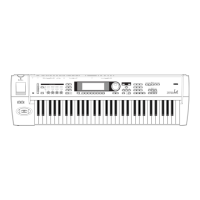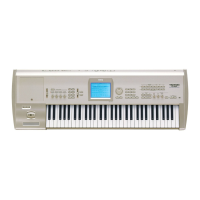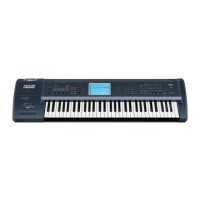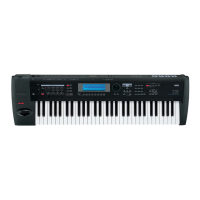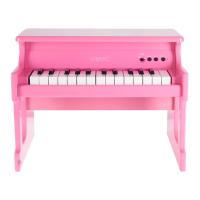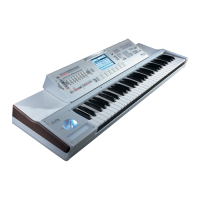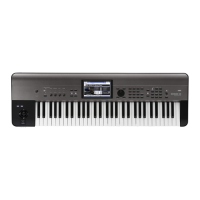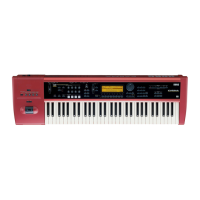8
14.SEQUENCER/SAMPLING
(If the separately sold EXB-SMPL option is
installed)
[PAUSE] key
This key pauses playback of a song or cue list (the key
will light). Press the key again to cancel Pause (the key
will go dark).
[ REW] key
This key rewinds playback of a song or cue list.
Rewind will occur when you press the key (the key
will light). (This will not operate during recording.)
[FF ] key
This key fast-forwards playback of a song or cue list.
Fast-forward will occur when you press the key (the
key will light). (This will not operate during record-
ing.)
[LOCATE] key
This key resets the playback location of a song or cue
list to a specified location. You can also press this key
when “stuck notes” occur for some reason.
[REC/WRITE] key
When you press this key in Sequencer mode, the
TRITON Le will enter recording-ready mode (the key
will light). If you then press the [START/STOP] key,
recording will start. (
☞p.78)
When you press this key in Program, Combination, or
Global modes, a dialog box will appear. If you then
press the [F8] (“OK”) key, the edited content will be
written. (
☞p.42, 44)
When you press this key in Sampling mode (if the
EXB-SMPL option is installed) and then press the
[START/STOP] key, sample recording will begin.
(
☞p.34)
[START/STOP] key
In Sequencer mode, this key starts/stops song record-
ing/playback, or cue list playback. (The key will blink
in time with the beat during recording or playback.)
In Sampling mode (if the EXB-SMPL option is
installed), press the [REC/WRITE] key and then press
the [START/STOP] key to start/stop sample recording.
In the SMPL 2.1–2: Sample Edit, Edit2 page, pressing
this key will sound the sample.
Rear panel
1. SmartMedia slot
SmartMedia cards can be inserted here (☞p.5).
2. [POWER] switch
This switch turns the power on/off (☞p.17).
3. AC power supply connector (~AC9V)
Connect this to the included AC/AC power supply.
After connecting the power supply cable to TRITON
Le, connect the other end to an AC outlet (
☞p.12).
4. AUDIO OUTPUT
Connect these outputs to the input jacks of your amp
or mixer. In addition to the L/MONO and R main ste-
reo audio outputs, TRITON Le provides two individ-
ual audio outputs. The sound from each oscillator,
drum, timbre/track, or insertion effect can be freely
routed to any output (
☞p.108–).
(MAIN) L/MONO, R
These are unbalanced phone jacks (☞p.12).
These are the main audio output jacks. By setting “Bus
Select” to L/R, the output from an oscillator, an inser-
tion effect, an individual drum part, or the metronome
can be output to the (MAIN) L/MONO and R jacks.
When making connections in stereo, use L/MONO
and R. When making connections in mono, use the L/
MONO jack.
(INDIVIDUAL) 1, 2
These are unbalanced phone jacks (☞p.12).
These are individual (independent) audio output jacks.
By cycling the “Bus Select” through 1, 2, 1/2 an oscilla-
tor, an insertion effect, an individual drum part, or the
metronome etc. can be assigned to be output from the
(INDIVIDUAL) 1, 2 jacks. The output from the 1, 2
jacks is not affected by the [VOLUME] slider.
5. Pedal connections
ASSIGNABLE PEDAL jack
The separately sold Korg XVP-10 EXP/VOL pedal or
EXP-2 foot controller (options) can be connected to this
jack. (
☞p.13).
Its function can be assigned in Global mode, allowing
2
3
5
67
1
4
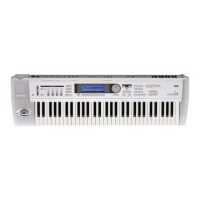
